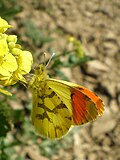| Provence orange tip | |
|---|---|
 | |
 | |
| Scientific classification | |
| Kingdom: | Animalia |
| Phylum: | Arthropoda |
| Class: | Insecta |
| Order: | Lepidoptera |
| Family: | Pieridae |
| Genus: | Anthocharis |
| Species: | A. euphenoides |
| Binomial name | |
| Anthocharis euphenoides Staudinger, 1869 | |
 | |
Anthocharis euphenoides, the Provence orange tip, is a species of butterfly in the family Pieridae. It is found in the Iberian Peninsula (missing in the southwest and northeast), in the south of France (from the eastern Pyrenees to the Alpes-Maritimes) and in Italy in the Abruzzo. There are a few records from Switzerland (Southern Ticino). Its caterpillars use Biscutella as their food source.







